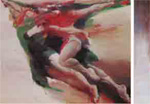Shamsul Wares
 Liberation War, in which Shahabuddin Ahmed actively participated as a freedom fighter at the age of 21 — the massacre of innocent people, shocking personal experience of being caught up between life and death, fierce resistance of freedom fighters and the ultimate victory — seems to form his emotional built as a painter. His troubled memories of the war, like nightmares, still haunt him. It is no wonder then that his paintings are rooted in 1971.
Liberation War, in which Shahabuddin Ahmed actively participated as a freedom fighter at the age of 21 — the massacre of innocent people, shocking personal experience of being caught up between life and death, fierce resistance of freedom fighters and the ultimate victory — seems to form his emotional built as a painter. His troubled memories of the war, like nightmares, still haunt him. It is no wonder then that his paintings are rooted in 1971.
Young athletic figures of the freedom fighters with heavy lower limbs appear in his paintings — torn in pain, attempting to reach out to freedom. His paintings focus on these naked figures in intense motion, often faceless, dissolving within, as if corroded by some kind of acid but stretching out with full energy and vigour towards the free world. These figures are so depicted with bold thick brushwork against simple empty space textured by light and shade. Nothing distracts the attention from the focused subject. Although the troubled human figures are symbolic of the perception of the war, these images also express the endless human struggle against all odds to achieve better life and dignity.
In many of his paintings he depicts single human figures placed in the infinite space where the man faces the universe alone, as if there is nothing in between — no society, culture, faith or custom. Here the image is executed disturbingly with distortion, twist, rupture, obscurity and a touch of Baconian ambience. Shahabuddin seems deeply concerned with solitude as the inevitable condition of the modern man, who is a victim of his own will. These paintings display a calm sense of psychological aberration, where Shahabuddin displaces the aggression, hatred and neglect into his painted figures; the subjects release his internal aggression and pain. This way he communicates with the viewers on an intimate scale.
Some of the postures of the figures have affiliation with the style popularised by the former Soviet Union, but in fact his paintings are neither social nor socialistic, rather the result of a kind of consumerist super-capitalism.
Shahabuddin’s fascination with figurative sculpture is also discernable in most of his paintings. His painted images behold what is sculpturesque and in this way he seems to connect himself with Michelangelo. European physical characteristics of his figures also seem to be a natural derivation of his long habitation in Paris (since 1975) and his love for Renaissance paintings.
Shahabuddin’s portraits are very expressive of his passion for some of the great heroes of South Asia. In these works he has been able to maintain his delirious method of creating forms with meticulous rendering where the depicted characters gain an increased intensity. He also works out the same intensity while he executes animal forms.
Shahabuddin is a restless painter, who instead of looking for new subjects has been consistently working on the same subject in order to rediscover what has already been discovered. But in his magical spell he seems to find every time a new interpretation of his subject, the ruptured man. He is definitely engaged in the task of digging out a world within an atom.
Article originally published on The Daily Star
The writer is a noted architect and art critic.




















